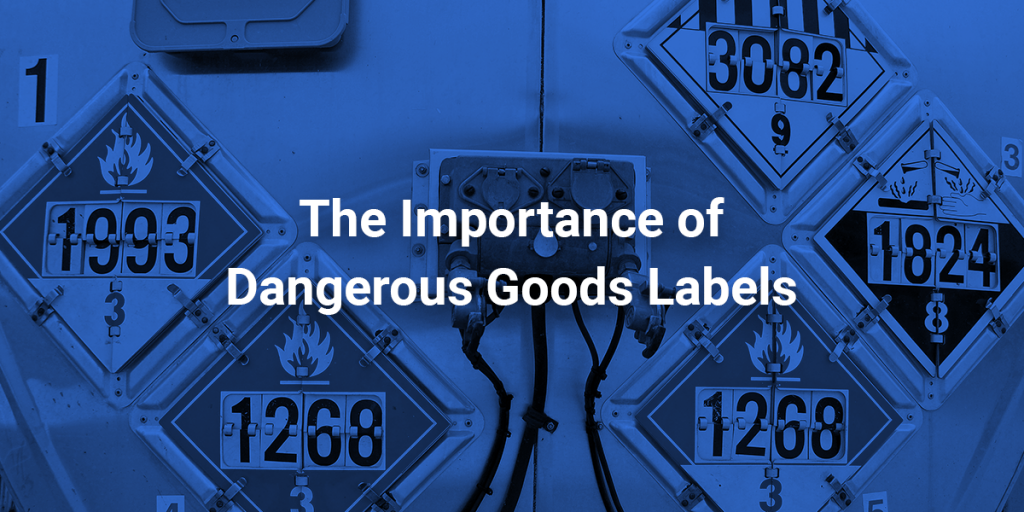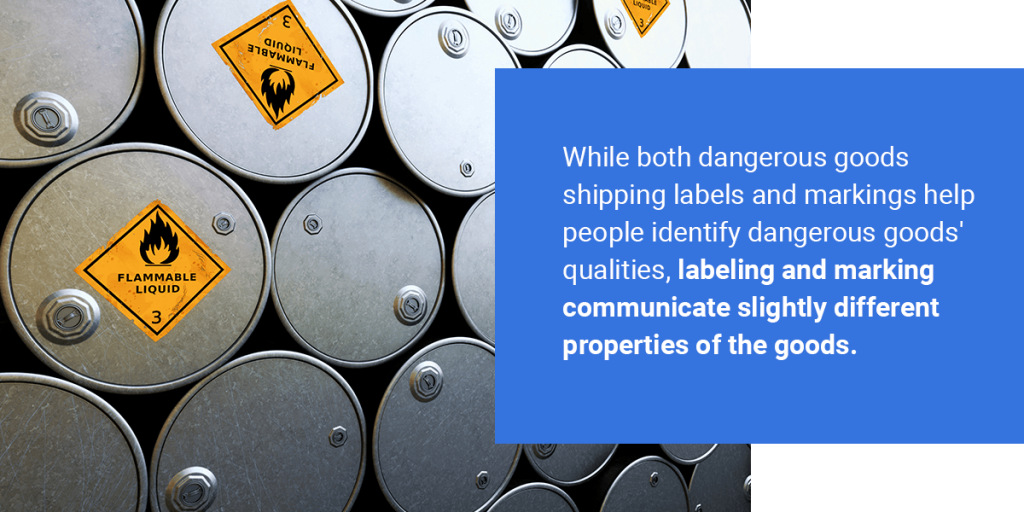
If you’re in an industry that requires storing or shipping materials like compressed gases, chemicals, fertilizers or pharmaceutical goods, you’ll want to understand how to safely transport harmful substances and the proper dangerous goods labels to use. Read more to learn about what dangerous goods are, dangerous goods markings, how to properly label these materials and how to safely store and transport hazardous substances.
Table of Contents
- What Are Dangerous Goods?
- Types of Dangerous Goods Labels
- Labeling of Dangerous Goods: What Is Dangerous Goods Marking?
- How Can I Safely Store and Transport Goods?
- Contact Klinge Corporation for Hazmat Containers
What Are Dangerous Goods?
A dangerous good, also known as a hazardous material or hazmat, is any material that poses a risk to human health, property or the environment during transportation. We often don’t realize how common dangerous goods are in our daily lives. However, we ship more than three billion tons of these materials in the U.S. each year. Dangerous goods require proper handling, shipping and storage to protect your health and property.
Types of Dangerous Goods Labels
The National Code of Federal Regulations lists nine classes of dangerous goods and dangerous goods class labels:
- Explosives: An explosive is any substance or device that is either designed to explode, such as by rapidly releasing gas or heat, or has an internal chemical reaction that makes it explosive. There are six divisions of explosives. Common explosives include fireworks, gun powder, and airbag inflators and modules.
- Gases: There are three divisions of gases. The first division, flammable gases, is any gas that will ignite at a concentration of 13% or less in air. These gases also have a flammable range of at least 12%. Examples of the first division include camp stoves, propane tanks and spray cosmetics. The second division comprises non-flammable, non-toxic compressed gases like fire extinguishers, carbon dioxide and nitrogen. The third division includes poisonous gases, such as hydrogen sulfide or hydrogen cyanide, that are toxic to humans in transportation.
- Flammable liquids: A liquid is flammable or combustible when it has a flashpoint less than 60° C (140° F) or has a flashpoint at or above 37.8° C (100° F) like gasoline, camp fuels, paint or ethanol.
- Flammable solids: The fourth classification of dangerous goods, flammable solids, are combustible during ignition in normal conditions. There are four divisions of flammable solids. The first includes self-reactive, thermally unstable materials and those that are combustible through friction, such as matches. The second is spontaneously combustible materials like activated carbon, coal and rags with residues from oil or paint. The third includes materials that are flammable or emit a flammable gas when wet, like lithium, magnesium or aluminum powder.
- Oxidizing substances and organic peroxides: Oxidizing materials readily give off oxygen or other oxidizing substances or chemically react to oxidize combustible materials. There are two divisions, oxidizing substances like hydrogen peroxide, fluorine or oxygen generators and cylinders, and organic peroxides like accelerators, resins or acetone peroxide.
- Poisons and infectious substances: There are two divisions of toxic substances, poisons and infectious substances. Poisonous materials are so toxic to humans that they are hazardous during transportation due to oral, dermal or inhalation toxicity. Examples include arsenic, pesticides and some medicines. Infectious substances are items like used needles or blood samples that could potentially contain a pathogen and spread diseases like HIV or Hepatitis B.
- Radioactive materials: Radioactive materials like radioactive medicines, X-ray machines or smoke alarms are unstable and release radionuclides during decay.
- Corrosives: Corrosives are highly reactive substances like most acids, wet and NiCad batteries and mercury thermometers that chemically cause damage to human tissue.
- Miscellaneous hazardous materials: This classification includes all other hazardous materials that may be hazardous to human health or the environment but do not fall under one of the previous categories. Examples include dry ice, engines, lithium batteries and ammonium nitrate fertilizers.

Dangerous Goods Labeling: What Is Dangerous Goods Marking?
While both dangerous goods shipping labels and markings help people identify dangerous goods’ qualities, labeling and marking communicate slightly different properties of the goods.
Dangerous goods transport labels communicate the primary hazards posed by the dangerous goods. People handling dangerous materials can immediately identify any hazardous materials in the package through colors, codes and pictograms such as hazard symbols or handling labels. Transport labels for dangerous goods must be clearly printed on or affixed to the surface of the package in a location other than the bottom and near the shipping marking, as they inform how to transport, handle and store dangerous goods.
On the other hand, marking conveys the specific hazards dangerous goods pose more specifically than labeling. Marking includes a descriptive name, the UN/ID number, the full name and address of the shipper and recipient, instructions and cautions and weight. Specific dangerous goods require specific marks, so be sure to review hazardous material marking requirements.
Marks must meet certain requirements to properly communicate the substance’s hazards. Marks must be:
- Durable, in plain English and clearly printed on or affixed to the outside of the package
- Displayed on a background of a sharply contrasting color
- Unobscured by other labels and attachments
- Located away from other markings like advertising that could reduce the mark’s effectiveness
How Can I Safely Store and Transport Goods?
The first step in safely transporting dangerous goods on U.S. roads and storing them once they have reached their destination is to identify the material on the OSHA Safety Data Sheet, which includes information on the properties of and potential hazards caused by various substances. The Safety Data Sheet also provides information on safely transporting hazardous materials, including proper shipping names and packing groups.
You should also look at the Hazardous Materials Table to discover any special provisions or exceptions for different hazardous goods. According to the Department of Transportation, knowing the correct hazard classification is one of the most important steps when getting started with shipping dangerous substances, as all other shipping requirements will be based on the product’s hazard classification.
If you’re shipping internationally across the ocean, you should understand the United Nations International Maritime Organization’s International Maritime Dangerous Goods, or IMDG, code. The code classifies dangerous goods according to nine categories and gives regulations for handling different types of dangerous goods. The IMDG code helps crew members properly identify and classify different types of dangerous goods to safely handle and stow them. If an incident does happen, IMDG labeling will also help the crew determine how best to respond.
Next, determine the quantity of the hazardous material you’re going to ship and select the appropriate packaging for the particular material. If you need to use performance packaging, you must strictly follow the manufacturer’s instructions to make sure the hazardous material is properly contained.
After selecting the proper packaging, apply the required dangerous goods hazard labels and markings according to the class of dangerous goods and the requirements for your shipment. Then, prepare a shipping paper before sending your package off with the carrier of your choice.
Knowing how to properly store hazardous goods is also crucial before, during and after transport. These materials should be stored in closeable cabinets with a front edge lip and should never be stored near loading docks or other areas with high levels of traffic. Best practices include storing hazardous goods in a separate anti-spill room with an above-ground door to trap spilled materials and only allowing qualified individuals to handle dangerous substances.

Contact Klinge Corporation for Hazmat Containers
If you’re in an industry where you frequently need to store and ship dangerous goods, you’ll want to make sure you select a proper container to ensure hazardous materials safely arrive at their destination. Our refrigerated transport containers allow you to safely ship chemicals and pharmaceutical goods under strict industry regulations. Contact Klinge Corporation today to talk to a specialist and discover the available container options for storing and shipping dangerous goods.
